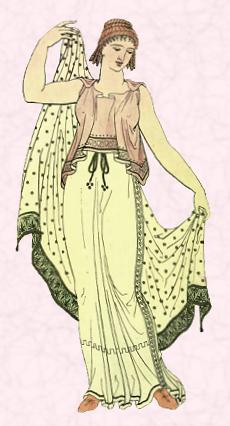GREECE : COSTUMES AND FASHION
The typical clothing that ancient men and women wore consisted of two pieces of clothing draped around the body - a cloak ( himation or chlamys) and an undergarment (chiton or peplos), Clothes were customarily made at home of different lengths and breadths and these pieces were often interchangeable too! They were made out of wool or rectangular linen fabric with extra accessories like clasps, pins or a belt. Unfortunately, none of the clothes have survived from this period although they served many purposes, for example, bedding. Mostly, the common clothing included incorporating decorative borders on plain white cloth. Evidence can be traced for elaborate designs and bright colours- but they were definitely less common.
 |
| Fig: An overall look of both men and women. |
Ancient Greece consisted primarily of Chiton, Peplos, Himation and Chlamys. They can be explained as follows:
 |
| Fig: Parts of the clothing. |
CHITON
A simple tunic garment worn by both genders and all ages in lighter linen is called chiton. Secured along the shoulders, It included wide rectangular tubes. They fell to the ankles of the person wearing it , typically. However, shorter lengths were worn by people interested in harsh activities (athletics, wars etc). A cloak or a himation could be worn over a chiton.
PEPLOS
A square piece of cloth thats the predecessor (worn over) the chiton is called the peplos. It is folded and pinned at both shoulders. Sometimes it was worn alone i.e as an alternative for a chiton.
HIMATION
A basic garment worn over a chiton is called himation. It is made up of a very heavy rectangular material which passes under the left arm and settles at the right shoulder. A cloak could also be placed in a similar way. In cold weather, more volumes of himation could be worn. Also, it is said that this himation was pulled up over the head if incase the wearer faced emotion or shame.
CHLAMYS
Men wore seamless rectangular woollen material for hunting and military purposes called chlamys. This was again worn as a clock secured at the right shoulder which fancy buttons or broaches. This clothing is famous particularly from the 5th to the 3rd century BC as it came to be known as a Greek military attire.
FABRIC
 |
| Fig: Ancient Greek Clothing |
FABRIC
Ancient Greek clothing was made up of wool mostly, silk and linen. This production of fabric was rather a long and tedious process and the ready made clothing was highly expensive.
FOOTWEAR
They roamed around barefoot at home. Otherwise, they wore sandals, slippers, soft shoes and boots.
JEWELLERY
Small ornaments in gold were sewn into the clothing and would sparkle as one moved. Elaborate hairstyles and makeup were prominent.

No comments:
Post a Comment